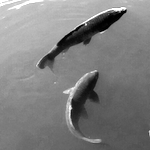Fish schooling inline obtain hydrodynamic benefits by interacting with the wake of upstream swimmers. This involves many complex interactions between the downstream swimmer and the vortices generated by the upstream swimmer. However, basic characteristics of this interaction have been observed and can be used to simplify the dynamics. We use these findings to study the configuration of two fish swimming inline. Specifically, the contributions of this work are (1) a simplified dynamic model of a downstream swimmer's position based on experimentally observed behaviors; (2) the introduction of a input signal that controls the relative phase difference between the swimmers; and (3) an analysis of the open-loop and closed-loop systems. In particular, we find and characterize the stable limit cycle that appears when feedback control is applied. This work has applications in the propulsion of bio-inspired underwater vehicles.

 PDF version
PDF version
